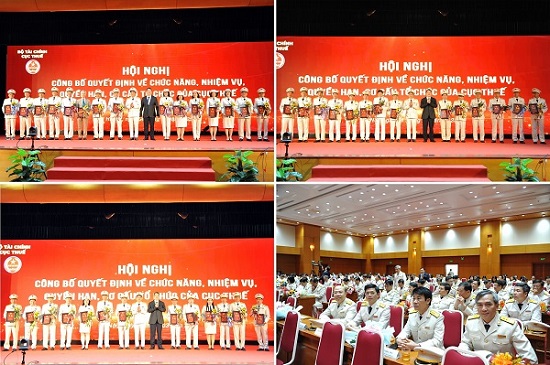On the afternoon of March 4, the Tax Department held a conference to announce the Decision on functions, tasks, powers and new organizational structure.
Director of the Tax Department Mai Xuan Thanh affirmed: "This is not only a change in organizational structure, but also a strong transformation to improve operational efficiency, ensure a smooth and transparent operating apparatus, meeting the requirements of socio-economic development".

Reduced by more than 1,000 units
According to Decision 381/QD-BTC issued on February 26, 2025, the tax sector's organizational model has undergone major changes. 63 provincial and municipal Tax Departments are reorganized into 20 regional Tax Departments, 413 district and county Tax Departments are streamlined to 350 tax groups. Thus, the total number of management units has decreased by 1,033 units, equivalent to 24.95%.
Streamlining the apparatus is an important step to improve tax management efficiency, help optimize resources, reduce operating costs, and increase the application of technology in management. Director Mai Xuan Thanh emphasized: "This change not only aims to streamline the organization but also creates conditions for the Tax sector to operate more effectively, serving people and businesses in the best way".
Deputy Minister of Finance Cao Anh Tuan highly appreciated the efforts of the Tax sector in implementing the policy of streamlining the apparatus: "Relaxing the apparatus is an inevitable requirement to improve efficiency and efficiency, towards a modern and transparent administration. I believe that with high determination, the Tax sector will continue to promote its important role in national financial management".
Ensuring effective and uninterrupted operation
In order to ensure the effective operation of the new apparatus, the Tax sector has set out the following key tasks:
Stably organize at local units, ensure tax management and administrative procedures run normally, without affecting taxpayers.
Focus on implementing budget collection solutions, striving to complete assigned tasks, closely following the collection estimate, synchronously implementing collection management measures, preventing revenue loss and collecting outstanding tax debts.
Resolutely implement topics against tax loss, especially in areas such as e-commerce, accommodation services, restaurants, golf courses. At the same time, strengthen control over businesses that have suffered losses for many years but still expand production and signs of price change.
Promote the application of technology, digital transformation in tax management, deploy an early warning system to promptly detect risks of tax fraud.
Promote administrative procedure reform, simplify processes, expand electronic tax services to create maximum convenience for taxpayers.
Enhance the responsibility of tax civil servants in performing public duties, resolutely and strictly handle tax fraud, harassment, and negativity.
Director Mai Xuan Thanh emphasized: The Tax Department will deploy a survey application to assess the quality and service attitude of tax officials for each tax collection agency as well as throughout the tax management process. Scoring results are an important measure to evaluate civil servants, consider, arrange job positions, plan, appoint and orient training and fostering work. Thereby, further enhancing the prestige of the industry as well as promoting voluntary compliance of taxpayers, indirectly increasing the efficiency of management and budget collection".

Organize the apparatus according to the three-level model
The Tax sector is organized according to a three-level model with 12 units at the Central level to help the Director perform the function of state management of taxes, including: Office; International Policy and Tax Department; Legal Department; Tax Professional Department; Tax Accounting, Accounting, Statistics Department; Tax Protection and Support Management Board; Technology, Digital Transformation and Automation Board; Inspection and Inspection Board; Cadre Organization Board; Finance and Governance Board; Large Enterprise Tax Department (DNL); E-commerce Tax Department (TMDT).
Local Tax Departments are organized in 20 areas.
At the conference, the Tax Department announced decisions to appoint leaders of units in the new system. Representatives of the leaders of the Tax Departments in the region pledged to be determined to perform well the assigned tasks, ensuring effective and transparent tax management.











